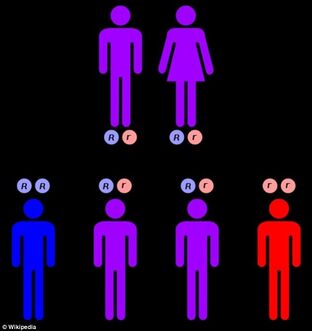In the Appalachian Mountains rests a medical oddity so unusual that it at first seems a massive hoax.
Dating back to the early 1800s, an isolated family in eastern Kentucky - who can trace their roots back to a French orphan - started producing children who were blue.
As a result of a coincidental meeting of recessive genes, intermarriage and inbreeding, members of the Fugate family were born with a rare condition that made them visibly discoloured.

Feeling blue: Due to inbreeding and inter-marriage, a rural family developed a rare skin discolouration
The mystery behind the astonishing picture of the Fugates, which has been baffling people for years, appears to have finally been solved.
It began when Martin Fugate, a French orphan, settled on the banks of eastern Kentucky's Troublesome Creek to claim a land grant in the early 19th century.
He married a red-haired American named Elizabeth Smith - who had a very pale complexion - and their union formed a genetic mutation that resulted in their descendants being born with blue skin.
Looking at the portrait, they appear to have been either Photoshopped or made up to mimic characters from children's cartoon The Smurfs, but science proves that the condition is in fact real.

The Fugates lived in an isolated part of eastern Kentucky and had little opportunity to mix with others

A photo of Lorenzo 'Blue Anze' Dow Fugate and Eleanor Fugate, taken around 1915
Called methaemoglobinaemia (commonly known as met-H), the condition reduces the individual’s ability to carry oxygen in their blood. As a result, their blood is darker than the colour typically found running through people’s veins.
The family was first discovered in 1958 when one of the blue men, Luke Combs, who was a descendant of another branch of the Fugate family, took his white wife to the University of Kentucky Hospital and doctors paid more attention to him than his wife.Because the Fugate family lived in such an isolated part of the Kentucky, they intermarried with a neighbouring family for generations which led to a relatively ‘pure’ gene pool where the met-H gene appeared much more frequently.
‘Luke was just as blue as Lake Louise on a cool summer day,’ doctor Charles H. Behlen II told the Tri-City Herald in 1974.
Aside from the stark discoloration of the carrier’s skin, there are no serious problems associated with the disease.

Methaemoglobinaemia (commonly known as met-H) is a recessive gene (shown by the small r) so only produces 'blue' people in very rare circumstances
In 1980, a counter-intuitive solution was discovered where the blue person drinks a chemical-filled solution that is itself blue. This then turns the carrier’s blood into a ‘normal’ red hue which is then reflected in a change in skin tone.
Because of the dispersion of fluids, the solution only lasts for about a day so the carrier would have to drink a serving every day.
'They weren’t sick; it was just the way they look. They’re normal people - they’re good people'
-Nurse Ruth Pendergrass
As eastern Kentucky has become vastly more populated than the early 19th century, and as more genes are married into the Fugate family tree, there were far fewer children born with the condition.
That said, the recessive met-H gene lingers to this day, but it is statistically insignificant now.
‘They weren’t sick; it was just the way they look,’ said nurse Ruth Pendergrass in the Tri-City Herald article. 'They’re normal people - they’re good people.’